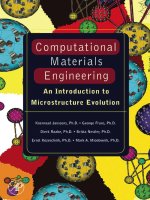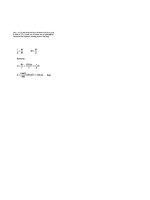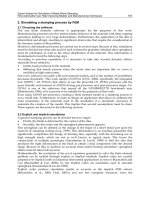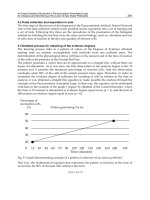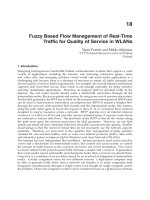NAVFAC P-433 Welding Materials Handbook_2 pot
Bạn đang xem bản rút gọn của tài liệu. Xem và tải ngay bản đầy đủ của tài liệu tại đây (88.63 KB, 17 trang )
TYPE
NSN:
BRAZING - ARC
alloy sections 250- 400°F (except silicon, bronze).
Use medium arc gap. (NOTE USE GOOD
9GJ 3439-00-262-2739 (1/8x14)
VENTILATION. Hold electrode 10-15 degrees off
9GD 3439-01-131-4934 (5/32X 14)
perpendicular.)
POSITION: Flat
CHARACTERISTICS:
Has rapid deposition rate. Deposit is a copper-base
POLARITY: DC Reverse
alloy.
RECOMMENDED AMPERAGES:
Hardness: Deposited 130 BHN
1/8 - 80 to 160
Work Hardens to 230 BHN
3/16 -130 to 250
Tensile Strength: 90,000 psig
USES:
Primary: For high-strength joints on cast iron, steel,
and copper alloys. For joints and dissimilar
combinations susceptible to cracking. Excellent for
overlaying surfaces subject to frictional wear and
corrosive attack by salt water.
Secondary: Can be used for joining stainless,
nickel, and nickel alloys.
PROCEDURES:
Bevel crack to 90° angle. Preheat heavy steel and
cast iron sections to 200°F. Preheat heavy copper
1-15
Simpo PDF Merge and Split Unregistered Version -
TYPE: ALUMINUM - ARC
(extruded flux-coated rod) E-4043
NSN: 9GD 3439-00-803-9496 (3/64x14)
9GD 3439-00-165-4177 (1/8X 14)
9GD 3439-01-139-3498 (5/32X 14)
9GD 3439-00-246-0541 (3/16X 14)
POSITION: Flat, horizontal, or vertical
POLARITY: DC Reverse
RECOMMENDED AMPERAGES:
1/8 - 90 to 140
5/32 -125 to 175
USES:
Primary: Arc welding of all weldable grades of
aluminum in extruded, plate or sheet, and sand and die
castings. Use for welding aluminum landing mats
when GMA is not available or dirt, moisture, or wind
make GMA impractical.
Secondary: Use with torch for welding aluminum.
To make an aluminum paste flux, break flux off rod,
1-16
pulverize, mix with a few drops of water. Can be used
with carbon arc, To use as a TGA rod, remove flux.
PROCEDURES:
Bevel 1/8 in. or heavier to 750 vee. On heavy
sections, preheat to 400°F. Maintain short arc.
Hold electrode almost perpendicular to work or
slightly in direction of travel. Back whip at crater.
Chip slag before quenching. Use Marcoloy #500.
CHARACTERISTICS:
Keep rod dry; flux will absorb moisture from the air
easily.
Tensile Strength: 25,500 psig
Simpo PDF Merge and Split Unregistered Version -
TYPE: ALUMINUM - GMA
(Base Spooled Wire) E-5356
NSN: 9GD 3439-00-803-9498
(3/64 X 1 lb. spool)
POSITION: All
POLARITY: DC Reverse (Argon or helium gas)
RECOMMENDED CURRENT SETTINGS:
(3/16 plate-flat)
volts
Amen (cfh)
Amps
23-25 30-40
160-180
Weld Speed in Min
22-26
(NOTE: There is a different setting for each plate,
thickness, type of joint and position. Most of your
welding will be in the above ranges.)
USES:
This wire is recommended for welding 5056,5083,
5086,5154, and 5356 aluminum alloys. USE THIS
WIRE FOR WELDING ALUMINUM
LANDING
MATS.
PROCEDURES:
Wire and joint to be welded must be clean. Set your
machine and gas flow to the above settings and test on
a piece of scrap of similar thickness and type of joint in
the position you will be welding. Dirt on your work,
wire or feeding mechanism, or inadequate gas
coverage of your molten weld puddle will result in
porosity. Check for leaks into gas flow.
CHARACTERISTICS:
For general maintenance, use flux coated arc
aluminum rod on page 1-23. Save this wire for
welding aluminum landing mats.
Tensile Strength: 40,500 psig
Yield Strength: 21,000 psig
1-17
Simpo PDF Merge and Split Unregistered Version -
TYPE:
BRAZING, GAS —ALUMINUM
An extremely low melting aluminum alloy that
features high strength welds on most aluminums
NSN: 9GD 3439-01-030-2509 (3/32)
without melting the base metal.
9GD 3439-00-255-4576 (Flux)
Tensile Strength: 33,000 psi
POSITION: Flat
Bonding Temp: 1070°F
USES:
Joining of thin wall tubing, T-joints, lap and flanges,
sheets, extrusions, repair of aluminum furniture,
automotive trim, radiators, window frames, air
conditioning parts, motorcycle parts.
PROCEDURES:
Remove all grease, dirt, oil and oxides. Dip rod into
Marcoloy #1500 Flux or mix flux with alcohol or
water and brush paste on weld area. Heat uniformly
with reducing flame until flux liquifies, add alloy until
it flows through joint. Cool slowly, wash flux
thoroughly with water.
CHARACTERISTICS:
Yellow tip.
1-18
Simpo PDF Merge and Split Unregistered Version -
TYPE: ZINC DIE CAST and ALUMINUM
NSN: 9GD 3439-01-132-0140
USES:
Repair zinc die cast parts, automotive grills,
carburetors, fuel pumps castings and kirksite dies.
Aluminum castings and parts, such as sand holes, worn
parts and machining errors, can be filled or overlayed, .
PROCEDURES:
Remove all grease, dirt, oil and oxides. Zinc die cast:
Apply flux to surface, then heat with soft reducing
flame until flux liquifies. Melt off rod and remove
heat. Cool slowly. Wash flux off in water.
Aluminum: File or grind surface, use no flux, heat
indirectly and keep rubbing alloy on surface until it
wets out. Remove heat and allow to cool slowly.
TIG: No flux is required. Use high frequency AC and
argon gas.
CHARACTERISTICS:
Brown Tip.
Size: 1/8
Tensile Strength: 25,000 psig
Melting Point: 700°F
1-19
Simpo PDF Merge and Split Unregistered Version -
TYPE: STAINLESS - ARC (all steels - medium,
high carbon, alloy, and tool steels)
AWS-ASTM E 312-16
NSN: 9GD 3439-00-902-4209 (3/32X 14)
9GD 3439-00-165-4169 (1/8X 14)
9GD 3439-00-165-4166 (5/32X 14)
9GD 3439-00-165-4168 (3/16X 14)
POSITION: All
POLARITY: AC or DC Reverse
RECOMMENDED AMPERAGES:
3/32 - 50 to 90
1/8 - 90 to 120
5/32 -120 to 160
3/16 - 150 to 190
USES:
Primary: Use this rod when you need a high
strength weld deposit or when highly stressed joints,
vibration or shock continually cause weld failure. Use
on all steels and where destructive combinations of
wear, impact, corrosion, or heat are present.
Secondary: Can be used for welding stainless (no
acid) and salt-water pipe lines. Can be applied as a
buildup on manganese steel or any wear problem
involving frictional wear and impact.
PROCEDURES:
Bevel 90°. Preheat alloy steels to 400°F. Hold a
short arc. Use stringer beads. Run intermittent welds,
especially on high alloy steel. Peen lightly to relieve
stresses.
CHARACTERISTICS:
Bare rod can be applied with gas or GTA torch. Since
many other rods are capable of doing jobs that this rod
can do, conserve supplies and use it only for jobs
requiring its high tensile strength properties.
Tensile Strength: 120,000 psig
1-20
Simpo PDF Merge and Split Unregistered Version -
TYPE: BUILDUP - ARC (tungsten, high speed)
NSN: 3439-00-105-9948 (1/4X 14)
3439-01-032-5978 (1/16
X 14)
3439-00-902-4210 (3/16
X 14)
3439-00-105-9945 (3/32
X 14)
3439-01-012-1002 (3/64
X 14)
POSITION: All
POLARITY: AC/DC, Straight/Reverse
RECOMMENDED AMPERAGES:
1/8 -100 to 160
1/4 -200 to 280
5/32 -140 to 180
3/16 -180 to 240
USES:
Primary: To repair or rebuild high speed tools
without having to reharden the tool.
Secondary: Form tools, milling cutters, lathe bits,
boring bars and other tools usually made entirely of
high speed steel can be made compositely with only
the cutting surfaces made of high speed steel.
1-21
PROCEDURES:
For composite fabrication of cutting tools: machine or
grind surface, allow for approximately 3/16 in. of
finished weld metal. Preheat to approximately
400ºF. Apply one pass of Marcoloy #200 to
eliminate pickup of impurities from base metal to
ensure sound, homogeneous deposit of high speed steel
on the second pass.
CHARACTERISTICS:
This rod deposits a tungsten-moly high speed steel that
can be used for compositely fabricating tools for a
wide range of cutting conditions. Its “as-welded”
deposit is exceptionally tough and maybe used for
rough, deep cuts. It has good impact-resistant
characteristics. Tempered, this weld is ideal for
finishing cuts at higher speeds. Will hold its temper
and cutting qualities up to 1050°F.
Simpo PDF Merge and Split Unregistered Version -
TYPE: OVERLAY - ARC (manganese wearfacing)
NSN: 9GJ 3439-00-165-4172 (5/32x 1/4)
9GD 3439-00-165-4187 (3/16X 1/4)
POSITION: All
POLARITY: AC - DC Reverse
RECOMMENDED AMPERAGES:
5/32 -110 to 140
3/16 -150 to 220
USES:
Primary: This electrode is used for buildup and
overlay where severe impact and compression will be
encountered. This rod is excellent for building up and
joining manganese steel, for the restoration of buckets,
bucket teeth and lips, and crushers. It can be used for
joining steel to manganese, and steel to steel.
Secondary: Can be used for joining cast iron, if cast
rod is not available.
PROCEDURES:
Clean and remove remains of previous cracked or
brittle hard surfacing deposits. Keep the interpass
temperature on manganese steels low (less than
500°F). This can be done by back stepping and
skip-welding techniques that prevent localized
overheating.
CHARACTERISTICS :
This is a manganese chrome nickel electrode. It can be
used to build up worn steel parts, but should be held
for manganese steel jobs if the supply is limited.
(NOTE: DO NOT BUILDUP MANGANESE
CRUSHER ROLLS OR JAWS WITH A MILD
STEEL ROD OR A STEEL BUILDUP ROD UNLESS
STAINLESS ROD IS APPLIED FIRST.)
Hardness: As deposited RB 80-90
Work hardened RC 45-50
Tensile Strength: 150,000 psig
1-22
Simpo PDF Merge and Split Unregistered Version -
TYPE:
BUILDUP - ARC
- Tungsten
NSN: 3439-01-012-1002 (3/64)
3439-00-105-9945 (3/32)
3439-01-032-5978 (1/16)
3439-00-105-9948 (1/4)
3439-01-149-2831 (1/8)
POSITION: All
POLARITY: AC-DC Straight or Reverse
RECOMMENDED AMPERAGES: 135 to 175
USES:
Primary: For repairing or rebuilding high speed
tools (without the need to reharden the tools),
sprockets, rollers, tractor parts, excavator equipment,
etc. Excellent for heavy padding when toughness and
resistance to deformation is needed.
(NOTE: DO NOT USE AS A BUILDUP ON
MANGANESE STEEL.)
1-23
Simpo PDF Merge and Split Unregistered Version -
TYPE: BUILDUP - ARC (FeMn A-Class 3)
NSN: 9GD 3439-00-752-7818 (3/16X 14)
POSITION: All
POLARITY: AC-DC Straight or Reverse
RECOMMENDED AMPERAGES:
3/16 -135 to 175
USES:
Primary: On ferrous (steel) parts subject to heavy
shock loading and pounding. On hammers, sprockets,
rollers, tractor parts, excavator equipment, etc.
Excellent for heavy padding when high toughness and
resistance to deformation is needed.
(NOTE: DO NOT USE AS A BUILDUP ON
MANGANESE STEEL.)
Secondary: Can be used to join steel if steel rod is
NOT available.
1-24
PROCEDURES:
On heavy sections, preheat 200- 300°F. Hold a
short to medium arc and use a stringer or weaving
technique. Do not allow excessive heat buildup in
base metal. On large buildup, deposit succeeding
layers across previous layer to minimize peeling.
CHARACTERISTICS: Deposits are machinable.
Hardness: RC30
Simpo PDF Merge and Split Unregistered Version -
TYPE: OVERLAY - ARC (intermediate
wearfacing)
NSN: 9GD 3439-00-165-4182 (5/32X 14)
9GL 3439-00-165-4181 (3/16X 14)
POSITION: Flat, vertical, and horizontal
POLARITY: DC Reverse
RECOMMENDED AMPERAGES:
3/16 -140 to 200
USES:
On hard overlays subject to abrasive wear and medium
impact. When overlaying cast iron, first apply two
passes of cast iron rod, NSN 9GD 3439-00-165-4188.
PROCEDURES:
Preheat to about 200- 300°F on heavy sections.
Use weaving or stringer technique while holding a
short to medium arc. Do not allow excessive heat
buildup in the base metal.
1-25
CHARACTERISTICS:
At least two passes must be used to reduce the effects
of dilution.
Hardness: RC50
NOTE: For an electrode with all position
characteristics, including overhead position, use
MARCOLOY #702.
Simpo PDF Merge and Split Unregistered Version -
TYPE: OVERLAY - ARC (wearfacing - high
abrasion)
NSN: 9GJ 3439-00-165-4178 (1/8X 14)
9GD 3439-00-165-4179 (5/32X 14)
9GD 3439-00-165-4180 (3/16X 14)
POSITION: Flat - horizontal
POLARITY: AC -DC Straight
RECOMMENDED AMPERAGES:
1/8 - 80 to 130
5/32 -100 to 160
3/16 -160 to 240
USES:
For applications that require resistance to high abrasion
and erosion. (NOTE: use only where impact is low.)
PROCEDURES:
Use a medium arc with a slight weaving motion. A
long arc is recommended when wide, thinner-flowing
applications are desired. Do not weld beads longer
1-26
than 6 inches, and stagger welds to reduce local heat
build up. Use 1/8 in. diameter only on grader blades.
CHARACTERISTICS:
Any rate of cooling will give a high hardness.
Hardness: RC60
Simpo PDF Merge and Split Unregistered Version -
TYPE:
CHAMFERING or GOUGING- ARC
plane of the work. Strike arc and push chamfering rod
along the line of cut, quickly for a shallow groove,
NSN: 9GD 3439-00-453-5950 (1/8X 14)
more slowly or with a weaving motion, for a deeper
groove. If a deeper groove is required, repeat the
POSITION: All
procedure.
POLARITY: AC -DC Straight
CHARACTERISTICS:
The coating on this rod is heat resistant and the arc’s
RECOMMENDED AMPERAGES:
force is concentrated at the point of application.
1/8 -250 to 350
NOTE: For carbon arc gouging and cutting use
USES:
Marcolite Aluminum Carbons, 1/4x 12 inches (NSN
Primary: This electrode can be used for chamfering 3439-01-138-3106, Electrode Carbon Arc Aluminum
or gouging all metals. Used for preparing sections
1/4 for arc air.
prior to welding, gouging out unwanted or defective
weld metal.
Secondary: Can be used for cutting or piercing all
metals. Use to sear oil-soaked cast iron prior to
welding by holding a long arc and rapidly passing over
oil-soaked area.
PROCEDURES:
Insert electrode into electrode holder and point
electrode, like a lance, in the direction of travel. Hold
electrode at an angle not more than 300 with the
1-27
Simpo PDF Merge and Split Unregistered Version -
TYPE:
GRAPHITE
(carbon electrodes)
NSN: 9GD 3439-00-262-4228 (3/8X 12)
POLARITY: DC Straight
USES:
Brazing of sheet metal (galvanized). Preheating and
post-heating when a torch is not available. Cutting of
all metals (when a cutting rod or torch can’t be used).
Soldering (small work) by shorting carbon electrode
next to joint and feeding solder into a prefluxed seam.
Use to plug holes prior to welding or brazing or on
reverse polarity to deposit carbon to harden base metal.
CHARACTERISTICS:
Slow oxidation of the carbon electrode generates
carbon monoxide and carbon dioxide; these gases offer
some weld metal protection.
TYPE: SOLDER (tin - antimony 95/5)
NSN: 9GD 3439-00-088-8768 (1/8X 1 lb. spool)
USES:
Where moderately elevated temperature is a factor.
This solder has a plastic range of 12 degrees; it melts at
452°F and flows at 464°F. It has a higher
electrical conductivity than tin-lead solders and can be
used where lead is objectionable. Do not use on
aluminum, zinc, or zinc-coated metals such as
galvanized iron. When stocks are depleted, use the
tin-silver solder 96/4 on page 1-40.
PROCEDURES:
Clean and roughen surface as this solder makes a
stronger joint on a rough surface than on a polished
one. Joint clearances can be from 0.003 in. to a
maximum of 0.010 in. An improper fit requires more
solder and leaves the joint weaker. The flux to use is
NSN 9GD 3439-00-255-4566. Remove flux residue
after soldering joint.
1-28
Simpo PDF Merge and Split Unregistered Version -
TYPE: SOLDER (tin - lead 50/50) ASTM 50A
NSN: 9GK 3439-00-163-4347 (BAR)
9GD 3439-00-273-1637 (1/8X 5 lb. spool)
USES:
A general purpose solder recommended when a
combination of a relatively narrow pasty range, good
wetting properties, strength, and economy are desired.
Can be used as a wiping and sweating solder and on
radiator cores, electrical connections, heating units and
roofing seams.
PROCEDURES:
Clean and roughen surface as this solder makes a
stronger joint on rough surfaces than on polished ones.
Joint clearances can be from 0.003 in, to a maximum
of 0.010 in. An improper fit requires more solder and
leaves the joint weaker. The flux to use is NSN 9GD
3439-00-255-4566. Remove flux residue after
soldering joint.
Melting Temperature: 361°F
Flow Temperature: 421 ‘F
TYPE: SOLDER (tin - lead 40/60) ASTM 40A
NSN: 9GD 3439-00-188-6986 (3/8X 5 lb. spool)
USES:
This acid core, general purpose solder can be used
extensively on sheetmetal work. It is cheaper than
50/50 solder and can be used in similar applications.
No flux is needed on small work because of its acid
core. (NOTE: SEAL END OF WIRE AFTER
USING.)
PROCEDURES:
Clean and roughen surface as this solder makes a
stronger joint on a rough surface than on a polished
one. Joint clearances can be from 0.003 in. to a
maximum of 0.010 in. An improper fit requires more
solder and leaves the joint weaker. If more flux is
needed, use NSN 9GD 3439-00-255-4566. Remove
flux residue after soldering.
Melting Temperature: 361°F
Flow Temperature: 455°F
1-29
Simpo PDF Merge and Split Unregistered Version -
TYPE: SOLDER (tin - lead 60/40 rosin core)
NSN: 9GD 3439-00-184-8953 (3/32X 1 lb. spool)
USES:
For soldering instruments, where a “free” solder is
needed and temperature requirements are critical. For
soldering wiring because it has a narrow pasty range
and solidifies quickly. Use this solder on electrical
wiring because its core of rosin flux has a relatively
low corrosive nature.
PROCEDURES:
Clean and roughen surface because solder makes a
stronger joint on a rough surface than on a polished
one. Joint clearances can be from 0.003 in. to a
maximum of 0.010 in. An improper fit requires more
solder and leaves the joint weaker. In electrical work,
a closer tolerance gives better conductivity.
Melting Temperature: 361°F
Flow Temperature: 374ºF
TYPE: SOLDER (tin - silver 96/4)
NSN: 9GD 3439-00-968-3370 (1/8X 5 lb. spool)
USES:
For food and beverage containers requiring a
cadmium-free and lead-free solder. It retains a bright
finish, is a good color match for stainless steel, and is
excellent for joining dissimilar metals It is stronger
and has better electrical conductivity than tin-lead
solders and may be used for refrigeration work if
tin-antimony 95/5 solder is unavailable.
PROCEDURES:
Clean and roughen surface because solder makes a
stronger joint on a rough surface than on a polished
one. Joint clearances can be from 0.003 in. to a
maximum of 0.010 in. An improper fit requires more
solder and leaves the joint weaker. Use flux NSN
9GD 3439-00-018-1655. Remove flux residue after
soldering joint.
Use flux for cleaning (NSN 3439-00-255-9935)
1-30
Simpo PDF Merge and Split Unregistered Version -
TYPE: SOLDER (tin - lead 60/40 rosin core)
NSN: 9GD 3439-00-184-8953 (3/32X 1 lb. spool)
USES:
For soldering instruments, where a “free” solder is
needed and temperature requirements are critical. For
soldering wiring because it has a narrow pasty range
and solidifies quickly. Use this solder on electrical
wiring because its core of rosin flux has a relatively
low corrosive nature,
PROCEDURES:
Clean and roughen surface because solder makes a
stronger joint on a rough surface than on a polished
one. Joint clearances can be from 0.003 in. to a
maximum of 0.010 in. An improper fit requires more
solder and leaves the joint weaker. In electrical work,
a closer tolerance gives better conductivity.
Melting Temperature: 361ºF
Flow Temperature: 374°F
TYPE: SOLDER (tin - silver 96/4)
NSN: 9GD 3439-00-968-3370 (1/8X 5 lb. spool)
USES:
For food and beverage containers requiring a
cadmium-free and lead-free solder. It retains a bright
finish, is a good color match for stainless steel, and is
excellent for joining dissimilar metals It is stronger
and has better electrical conductivity than tin-lead
solders and may be used for refrigeration work if
tin-antimony 95/5 solder is unavailable.
PROCEDURES:
Clean and roughen surface because solder makes a
stronger joint on a rough surface than on a polished
one. Joint clearances can be from 0.003 in. to a
maximum of 0.010 in. An improper fit requires more
solder and leaves the joint weaker. Use flux NSN
9GD 3439-00-018-1655. Remove flux residue tier
soldering joint.
Use flux for cleaning (NSN 3439-00-255-9935)
1-30
Simpo PDF Merge and Split Unregistered Version -
